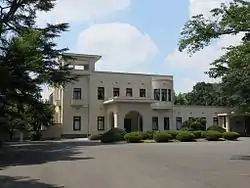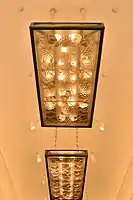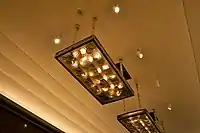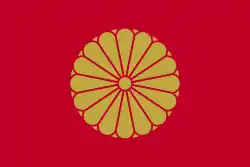Tokyo Metropolitan Teien Art Museum
The Tokyo Metropolitan Teien Art Museum (東京都庭園美術館, Tōkyō-to Teien Bijutsukan) is an art museum in Tokyo, Japan.
東京都庭園美術館 | |
 Teien Art Museum | |
 Location of The Tokyo Metropolitan Teien Art Museum in Japan | |
| Location | 5-21-9 Shirokanedai, Minato-ku, Tokyo, Japan |
|---|---|
| Coordinates | 3166-2 35.636889°N 139.719083°E |
| Type | Art museum |
| Owner | Tokyo Metropolitan Foundation for History and Culture |
| Website | http://www.teien-art-museum.ne.jp/en/ |
The museum is located in Minato ward, just east of Meguro Station. The Art Deco building, completed in 1933, has interiors designed by Henri Rapin and features decorative glass work by René Lalique.[1]
History
The Tokyo Metropolitan Teien Art Museum building was previously the residence of Prince Asaka Yasuhiko and his family from 1933 to 1947. The prince, who studied at the École Spéciale Militaire de Saint-Cyr in France, and travelled to the United States in 1925, was greatly enamoured of the Art Deco movement. On his return to Japan he commissioned the construction of his own private residence in this style. Although many of the interiors were designed according to plans submitted by Henri Rapin, the main architect of the building itself is credited as Gondo Yukichi of the Works Bureau of the Imperial Household Ministry.
After World War II the building served as the official residence of the Prime Minister (1947–50), and as a State Guest House (1950–74). The residence was first opened to the public as a museum in 1983. It is one of Japan's many museums which are supported by a prefectural government.[2] Teien means Japanese garden, and the museum is so named because the building is surrounded by a garden and sculptures.
Current facilities
After undergoing extensive renovation in 2013, the museum was re-opened in November 2014. The new museum annex, designed in collaboration with Hiroshi Sugimoto includes modern exhibition spaces, a café and museum shop.
Gallery
 Prince Asaka Residence
Prince Asaka Residence Teien Museum from Garden
Teien Museum from Garden Teien Museum Annex (completed 2014)
Teien Museum Annex (completed 2014) Museum Entrance
Museum Entrance Winter garden on the rooftop
Winter garden on the rooftop The illumination made of stained glass
The illumination made of stained glass This room was used for the Asakanomiya family's daily meals.
This room was used for the Asakanomiya family's daily meals. A lighting fixture of René Lalique in the great dining room
A lighting fixture of René Lalique in the great dining room A lighting fixture of René Lalique in the great dining room
A lighting fixture of René Lalique in the great dining room Ornament of pottery in around 1920 of Danish Royal Copenhagen which was modeled on the penguin put in the room
Ornament of pottery in around 1920 of Danish Royal Copenhagen which was modeled on the penguin put in the room A great dining room
A great dining room A white porcelain "perfume tower" in the room called "Tsugi-no-ma"[3]
A white porcelain "perfume tower" in the room called "Tsugi-no-ma"[3]
See also
References
- Flannigan, Thomas (1993). Tokyo Museum Guide: A Complete Guide. Tokyo: Charles E. Tuttle Publishing Co. p. 23. ISBN 978-1-4629-0424-2.
- Nussbaum, Louis-Frédéric. (2005). "Museums" in Japan Encyclopedia, pp. 671-673.
- The tower was designed by Henri Lapin in 1932 and built by the National Sabre Pottery Studio. Because the perfumed tower had a mechanism to allow water to flow, it was described as "Fountain" in drawings of the Imperial Household Ministry, etc., but later it came to be called "perfume tower" because Prince Asaka put perfume on the upper part of the lighting to give the fragrance by the heat of the lighting. At Savle Ceramics in France, it is recorded that "Vase Lumineux Rapin" (Lappan's Shining Container).
External links
| Wikimedia Commons has media related to Tokyo Metropolitan Teien Art Museum. |
- Tokyo Metropolitan Teien Art Museum: General information, English website.
